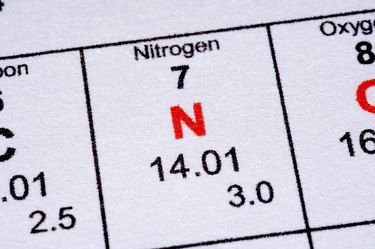Things You'll Need
Goggles, gloves, long-sleeved coat
200 mL graduated cylinder
Diphenylamine
Spatula and scale
Distilled water
Concentrated sulfuric acid
Plastic corrosion-resistant bottle (e.g., HDPE)
Glass container (e.g. ashtray, glass)
Pasteur pipette

Nitrogen in water will typically be found in the form of nitrates, water-soluble salts containing the negatively charged nitrate ion. One of the simplest tests to confirm the presence of nitrates is the diphenylamine test. It does involve the use of sulfuric acid, however, which is extremely toxic and corrosive, so do not perform this experiment if you have no experience working with these kinds of chemicals; even if you do, be extremely careful.
Step 1
Wear long pants, closed-toed shoes, gloves, chemical splash goggles and a long-sleeved coat. Concentrated sulfuric acid can cause severe burns if it comes in contact with your skin. Handle it carefully.
Video of the Day
Step 2
Weigh out 0.5 grams of diphenylamine and add it to the graduated cylinder, followed by 20 mL of distilled water. Stir or swirl until it dissolves.
Step 3
Add sulfuric acid to bring the total volume up to 100 mL. Add it slowly and carefully. Concentrated sulfuric acid releases considerable heat on contact with water. Do not add any additional water or any other chemicals.
Step 4
Store this solution in a corrosion-resistant plastic bottle away from heat in a cool dark place. Place this container inside a plastic tub so that if it leaks, the spill will be contained. Do not keep it above eye level or within reach of children.
Step 5
Place 10 or 15 drops of the water you want to test in your glass container.
Step 6
Add a few drops of the reagent you prepared earlier and watch the color of the solution. If the solution turns a deep blue in 30 minutes or less, nitrates are present at high levels. Do not assume just because you get a negative result, however, that nitrates are not present -- if they are present at trace levels, they will be more difficult to detect with this test. Some other oxidizing agents can occasionally cause this test to give a false-positive, although this is unusual.
Tip
If you are concerned that nitrates may be present in your drinking water, don't rely on this test for confirmation -- send a sample to a lab for testing. Labs can use more sophisticated equipment than you will have available to you outside the laboratory setting.
Warning
Concentrated sulfuric acid is a useful reagent in chemistry, but it is not a safe chemical. Do not attempt this procedure if you have no experience working with hazardous chemicals. Wear chemical splash goggles, gloves, long pants and other protective clothing and be extremely careful. Attempt this procedure only in a well-ventilated area (preferably under a fume hood if available).
Video of the Day